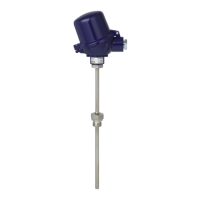3345267.08 06/2011 GB/D
12 WIKA operating instructions RTD and TC, intrinsically safe designs
GB
Potential measuring uncertainties due to ageing eects
Thermocouples are subject to ageing and change their temperature/thermal voltage
characteristic. Type J thermocouples of (Fe-Cu-Ni) age slightly due to oxidation of the pure metal
leg. In types K and N thermocouples (NiCrSi-NiSi), high temperatures can result in substantial
changes to the thermal voltage due to chrome depletion in the NiCr leg, leading to a lower thermal
voltage.
This eect is accelerated if there is a shortage of oxygen, since a complete oxide layer, which
would protect it from further oxidation, cannot be formed on the surface of the thermocouple.
The chromium in the alloy is oxidised, but not the nickel, giving rise to "green rot" that eventually
destroys the thermocouple. When NiCr-Ni thermocouples that have been operating above 700 °C
are cooled quickly, this cooling causes certain states in the crystal structure (short-range order)
to freeze, which in Ttype K thermocouples can result in a change of the thermal voltage of up to
0.8 mV (K eect).
In Type N thermocouple (NiCrSi-NiSi), it has been possible to reduce the short-range-order
eect by alloying both legs with silicon. The eect is reversible and is largely eliminated again by
annealing above 700 °C, followed by slow cooling. Thin sheathed thermocouples are particularly
sensitive. Cooling in still air can even result in deviations of more than 1 K.
The application range of these thermometers is limited both by the permissible max. temperature
of the thermocouple and by the max. temperature of the thermowell material.
Listed thermocouples are available both as single or duplex thermocouples. The thermocouple
will be delivered with an insulated measuring point, unless explicitly specied otherwise.
Sensor limiting error
A cold junction temperature of 0 °C is taken as basis with the denition of the tolerance value
of thermocouples. When using a compensating cable or thermocouple cable, an additional
measuring error must be considered.
For limiting errors and further specications see current WIKA data sheet or order
documentation.
3. Specications

